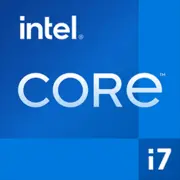Intel Core i7-1250U

Intel Core i7-1250U: A Hybrid Processor for Mobile Tasks. Full Review of 2025
Architecture and Process Technology: A Hybrid Approach and New Horizons
The Intel Core i7-1250U processor, released as part of the Alder Lake lineup, marks an important step in the evolution of mobile chips. Its architecture combines 10 cores (2 Performance cores and 8 Efficient cores) and 12 threads, providing flexibility in task distribution. The P-cores (Golden Cove) are responsible for high performance in single-threaded applications, while the E-cores (Gracemont) are optimized for background processes and energy efficiency.
The maximum turbo frequency reaches up to 4.7 GHz for P-cores, which is relevant for short bursts of workload (e.g., launching applications). E-cores operate at frequencies up to 3.5 GHz. The 12 MB L3 cache speeds up data processing, reducing latency.
The integrated graphics Intel Iris Xe (96 EU) supports 4K displays, hardware decoding of AV1, and light gaming at low settings. In 2025, it remains relevant for office laptops but falls behind discrete solutions and the Apple M3 in rendering tasks.
Intel's 7 process (formerly 10nm Enhanced SuperFin) provides a balance between performance and power consumption, which is particularly important for ultrabooks where every watt counts.
Power Consumption and TDP: How Intel Saves Power
The nominal TDP of the processor is 9W, but in reality, it dynamically adjusts from 7W to 29W thanks to Intel Dynamic Tuning technology. This allows laptops to adapt to workloads: for example, during video rendering, the chip temporarily increases power, while in reading mode, it minimizes it.
Key power-saving technologies include:
- Intel Thread Director – distributes tasks between P-cores and E-cores, reducing energy costs on background processes.
- Adaptix – machine learning algorithms for real-time optimization of frequencies and voltages.
As a result, even with active use, a laptop with the i7-1250U rarely overheats, and the fans operate quietly.
Performance: From Word Processing to Light Gaming
According to Geekbench 6 tests (1637 / 5354), the processor demonstrates:
- Single-threaded load: fast application launches, smooth browsing with dozens of tabs.
- Multi-threaded tasks: encoding a 10-minute video in HandBrake takes about 8 minutes (compared to 12 minutes for the i7-1165G7).
Real-world scenarios:
- Office work: simultaneous work with Excel, PowerPoint, Zoom, and over 20 Chrome tabs — without lags.
- Multimedia: editing in Adobe Premiere Rush (Full HD) using hardware acceleration.
- Gaming: CS:GO — 60-70 FPS on medium settings (1920x1080), Genshin Impact — 30-40 FPS on low.
Turbo mode maintains high frequencies for 20-25 seconds under load, after which the speed decreases to prevent overheating. In compact laptops (e.g., Lenovo Yoga Slim 7), this can lead to performance drops during prolonged rendering.
Use Cases: Who is the i7-1250U Suitable For?
- Students and freelancers: lightweight laptops for studying, document work, and online conferences.
- Mobile professionals: journalists, managers, designers (in connection with an external GPU for heavy tasks).
- Travelers: battery life of up to 14 hours (for example, in Asus ZenBook 13 OLED).
Not suitable for:
- Gamers demanding Ultra settings in AAA games.
- Engineers working with 3D models in SolidWorks.
Battery Life: How Long Will It Last?
With a TDP of 9W and a battery capacity of 60 Wh, the working time reaches:
- 12-14 hours — web surfing, office tasks (brightness at 150 nits).
- 8-9 hours — streaming video (Netflix, YouTube).
- 5-6 hours — photo editing in Lightroom.
Power-saving technologies:
- Connected Standby — background updates in sleep mode.
- Display Power Saving — automatic adjustment of brightness and screen refresh rate.
In 2025, the chip falls behind the Apple M3 in battery life (the MacBook Air with M3 works for up to 18 hours) but outperforms the AMD Ryzen 7 7730U (10-12 hours).
Comparison with Competitors: Who is Better?
- AMD Ryzen 7 7730U (Zen 3+): higher multi-threaded performance (Geekbench 6 Multi-Core ~6000), but weaker Radeon 680M graphics. Suitable for programmers.
- Apple M3: more energy efficient (up to 18 hours of operation), but limited compatibility with Windows applications.
- Intel Core i7-1260P (previous generation): higher TDP (28W), better for creative tasks, but battery life is 20% worse.
Prices for laptops with the i7-1250U in 2025: $900–$1300 (Dell XPS 13 — $1299, Acer Swift 5 — $999).
Pros and Cons
Strengths:
- Ideal balance of performance and battery life.
- Support for Thunderbolt 4 and Wi-Fi 6E.
- Affordable price for premium ultrabooks.
Weaknesses:
- Limited multi-threading power compared to Ryzen and Apple Silicon.
- Integrated graphics not suitable for serious gaming.
Laptop Selection Recommendations
1. Type of device: ultrabooks weighing up to 1.3 kg (HP Spectre x360, Microsoft Surface Laptop 5).
2. RAM: at least 16 GB LPDDR5 for multitasking.
3. Storage: SSD 512 GB NVMe.
4. Screen: IPS or OLED with a resolution of at least Full HD.
5. Ports: 2x Thunderbolt 4 for connecting docking stations.
Avoid models with passive cooling — they tend to throttle.
Final Conclusion
The Intel Core i7-1250U is an excellent choice for those who value mobility without compromising on basic performance. It is suitable for:
- Working on the go: long battery life and lightweight design.
- Home use: quick response for everyday tasks.
- Creativity: light photo and video editing.
However, if you need maximum power or gaming capabilities, consider processors with TDPs of 28W or higher, or discrete graphics. But convenience comes at the cost of weight and fan noise.
Basic
CPU Specifications
Memory Specifications
GPU Specifications
Miscellaneous
Benchmarks
Compared to Other CPU
Share in social media
Or Link To Us
<a href="https://cputronic.com/cpu/intel-core-i7-1250u" target="_blank">Intel Core i7-1250U</a>